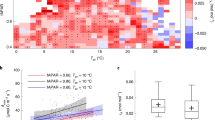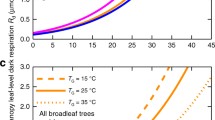Abstract
Regional and global models of the terrestrial biosphere depend critically on models of photosynthesis when predicting impacts of global change. This paper focuses on identifying the primary data needs of these models, what scales drive uncertainty, and how to improve measurements. Overall, there is a need for an open, cross-discipline database on leaf-level photosynthesis in general, and response curves in particular. The parameters in photosynthetic models are not constant through time, space, or canopy position but there is a need for a better understanding of whether relationships with drivers, such as leaf nitrogen, are themselves scale dependent. Across time scales, as ecosystem models become more sophisticated in their representations of succession they needs to be able to approximate sunfleck responses to capture understory growth and survival. At both high and low latitudes, photosynthetic data are inadequate in general and there is a particular need to better understand thermal acclimation. Simple models of acclimation suggest that shifts in optimal temperature are important. However, there is little advantage to synoptic-scale responses and circadian rhythms may be more beneficial than acclimation over shorter timescales. At high latitudes, there is a need for a better understanding of low-temperature photosynthetic limits, while at low latitudes the need is for a better understanding of phosphorus limitations on photosynthesis. In terms of sampling, measuring multivariate photosynthetic response surfaces are potentially more efficient and more accurate than traditional univariate response curves. Finally, there is a need for greater community involvement in model validation and model-data synthesis.


Similar content being viewed by others
References
Albani M, Medvigy DM, Hurtt GC, Moorcroft PR (2006) The contributions of land-use change, CO2 fertilization, and climate variability to the Eastern US carbon sink. Glob Change Biol 12(12):2370–2390. doi:10.1111/j.1365-2486.2006.01254.x
Amthor J (2000) The McCree–de Wit–Penning de Vries–Thornley Respiration Paradigms: 30 years later. Ann Bot 86(1):1–20. doi:10.1006/anbo.2000.1175
Asner GP, Martin RE (2009) Airborne spectranomics: mapping canopy chemical and taxonomic diversity in tropical forests. Front Ecol Environ 7(5):269–276. doi:10.1890/070152
Bernacchi CJ, Rosenthal DM, Pimentel C, Long SP, Farquhar GD (2009) Modeling the temperature dependence of C3 photosynthesis. In: Laisk A, Nedbal L, Govindjee (eds) Photosynthesis in silico: understanding complexity from molecules to ecosystems, vol 29. Springe, Netherlands, pp 231–246
Berry JA, Beerling DJ, Franks PJ (2010) Stomata: key players in the earth system, past and present. Curr Opin Plant Biol 13(3):233–240. doi:10.1016/j.pbi.2010.04.013
Bonan B, Lawrence PJ, Oleson KW, Levis S, Jung M, Reichstein M, Lawrence DM, Swenson SC (2011) Improving canopy processes in the Community Land Model version 4 (CLM4) using global flux fields empirically inferred from FLUXNET data. J Geophy Res 116(G2):1–22. doi:10.1029/2010JG001593
Bonan GB, Oleson KW, Fisher RA, Lasslop G, Reichstein M (2012) Reconciling leaf physiological traits and canopy flux data use of the TRY and FLUXNET databases in the Community Land Model version 4. J Geophys Res 117(25C):1–19. doi:10.1029/2011JG001913
Booth BBB, Jones CD, Collins M, Totterdell IJ, Cox PM, Sitch S, Huntingford C et al (2012). High sensitivity of future global warming to land carbon cycle processes. Environ Lett, 024002. doi:10.1088/1748-9326/7/2/024002
Clark JS (2005) Why environmental scientists are becoming bayesians. Ecol Lett 8(1):2–14. doi:10.1111/j.1461-0248.2004.00702.x
Clark JS, Dietze MC, Chakraborty S, Agarwal PK, Wolosin MS, Ibanez I, LaDeau S (2007) Resolving the biodiversity paradox. Ecol Lett 10(8):647–659. doi:10.1111/j.1461-0248.2007.01041.x discussion 659–62
Davidson CD (2012) The modeled effects of fire on carbon balance and vegetation abundance in Alaskan Tundra. University of Illinois, Urbana-Champaign, p 163
De Kauwe MG et al (2013) Forest water use and water use efficiency at elevated CO2: a model-data intercomparison at two contrasting temperate forest FACE sites. Glob Change Biol (in press). doi:10.1111/gcb.12164
Dietze MC, Clark JS (2008) Changing the gap dynamics paradigm: vegetative regeneration control on forest response to disturbance. Ecol Monogr 78(3):331–347. doi:10.1890/07-0271.1
Dietze M et al (2011) Characterizing the performance of ecosystem models across time scales: A spectral analysis of the North American carbon program site-level synthesis. J Geophys Res 116:1–15. doi:10.1029/2011JG001661
Dietze MC, LeBauer D, Kooper R (2013) On improving the communication between models and data. Plant Cell Environ (in press). doi:10.1111/pce.12043
Dios VR et al (2012) Endogenous circadian regulation of carbon dioxide exchange in terrestrial ecosystems. Glob Change Biol 18(6):1956–1970. doi:10.1111/j.1365-2486.2012.02664.x
Dubois J-JB, Fiscus EL, Booker FL, Flowers MD, Reid CD (2007) Optimizing the statistical estimation of the parameters of the Farquhar-von Caemmerer-Berry model of photosynthesis. New phytol 176(2):402–414. doi:10.1111/j.1469-8137.2007.02182.x
Ellis RJ (1979) The most abundant protein in the world. Trends Biochem Sci 4(11):241–244. doi:10.1016/0968-0004(79)90212-3
Farquhar G, Caemmerer S, Berry JA (1980) A biochemical model of photosynthetic CO2 assimilation in leaves of C3 species. Planta 149(1):78–90
Farquhar GD, von Caemmerer S, Berry JA (2001) Models of photosynthesis. Plant physiol 125(1):42–45
Foster DR, Aber JD (2006) Forests in time: the environmental consequences of 1000 years of change in New England. Yale University Press, New Haven
Foster D, Swanson F, Aber J, Burke I, Brokaw N, Tilman D, Knapp A (2003) The importance of land-use legacies to ecology and conservation. Bioscience 53(1):77. doi:10.1641/0006-3568
Friend AD (2010) Terrestrial plant production and climate change. J Exp Bot 61(5):1293–1309. doi:10.1093/jxb/erq019
Goll DS, Brovkin V, Parida BR, Reick CH, Kattge J, Reich PB, Van Bodegom PM et al (2012) Nutrient limitation reduces land carbon uptake in simulations with a model of combined carbon, nitrogen and phosphorus cycling. Biogeosciences 9(9):3547–3569. doi:10.5194/bg-9-3547-2012
Gross LJ, Kirschbaum MUF, Pearcy RW (1991) A dynamic model of photosynthesis in varying light taking account of stomatal conductance, C3-cycle intermediates, photorespiration and Rubisco activation. Plant Cell Environ 14:881–893. doi:10.1111/j.1365-3040.1991.tb00957.x
Gu L, Pallardy SG, Tu K, Law BE, Wullschleger SD (2010) Reliable estimation of biochemical parameters from C3 leaf photosynthesis-intercellular carbon dioxide response curves. Plant Cell Environ 33(11):1852–1874. doi:10.1111/j.1365-3040.2010.02192.x
Harmer SL (2009) The circadian system in higher plants. Annu Rev Plant Biol 60:357–377. doi:10.1146/annurev.arplant.043008.092054
Harpole W et al (2011) Nutrient co-limitation of primary producer communities. Ecol Lett 14:852–862. doi:10.1111/j.1461-0248.2011.01651.x
Hennessey TL, Field CB (1991) Circadian rhythms in photosynthesis. Plant Physiol 96:831–836
Hey T, Tansley S, Tolle K (eds) (2009) The fourth paradigm: data-intensive scientific discovery. Microsoft Research, Redmond
Kattge J, Knorr W (2007) Temperature acclimation in a biochemical model of photosynthesis: a reanalysis of data from 36 species. Plant Cell Environ 30(9):1176–1190. doi:10.1111/j.1365-3040.2007.01690.x
Kattge J, Knorr W, Raddatz T, Wirth C (2009) Quantifying photosynthetic capacity and its relationship to leaf nitrogen content for global-scale terrestrial biosphere models. Glob Change Biol 15(4):976–991. doi:10.1111/j.1365-2486.2008.01744.x
Kattge J et al (2011) TRY–a global database of plant traits. Glob Change Biol. doi:10.1111/j.1365-2486.2011.02451.x
Leakey ADB, Press MC, Scholes JD, Watling JR (2002) Relative enhancement of photosynthesis and growth at elevated CO2 is greater under sunflecks than uniform irradiance in a tropical rain forest tree seedling. Plant Cell Environ 25(12):1701–1714. doi:10.1046/j.1365-3040.2002.00944.x
Leakey AD, Bishop KA, Ainsworth EA (2012) A multi-biome gap in understanding of crop and ecosystem responses to elevated CO(2). Curr Opin Plant Biol 15(3):228–236. doi:10.1016/j.pbi.2012.01.009
LeBauer DS, Wang D, Richter KT, Davidson CC, and Dietze MC (2012), Facilitating feedbacks between field measurements and ecosystem models. Ecol Monogr (in press). doi:10.1890/12-0137.1
Leuning R (1995) A critical appraisal of a combined stomatal-photosynthesis model for C3 plants. Plant Cell Environ 18(4):339–355. doi:10.1111/j.1365-3040.1995.tb00370.x
Lin Y-S, Medlyn BE, Ellsworth DS (2012) Temperature responses of leaf net photosynthesis: the role of component processes. Tree Physiol 32(2):219–231. doi:10.1093/treephys/tpr141
Long SP, Bernacchi CJ (2003) Gas exchange measurements, what can they tell us about the underlying limitations to photosynthesis? Procedures and sources of error. J Exp Bot 54(392):2393–2401. doi:10.1093/jxb/erg262
Medlyn BE, Dreyer E, Ellsworth D, Forstreuter M, Harley PC, Kirschbaum MUF, Roux XLE (2002) Temperature response of parameters of a biochemically based model of photosynthesis. II. A review of experimental data. Plant Cell Environ 25:1167–1179
Medlyn BE, Duursma RA, Eamus D, Ellsworth DS, Prentice IC, Barton CVM, Crous KY, De Angelis P, Freeman M, Wingate L (2011) Reconciling the optimal and empirical approaches to modelling stomatal conductance. Glob Change Biol 17(6):2134–2144. doi:10.1111/j.1365-2486.2010.02375.x
Medvigy DM, Wofsy SC, Munger JW, Hollinger DY, Moorcroft PR (2009) Mechanistic scaling of ecosystem function and dynamics in space and time: ecosystem demography model version 2. J Geophys Res 114(G1):1–21. doi:10.1029/2008JG000812
Mohan JE, Clark JS, Schlesinger WH (2007) Long-term CO2 enrichment of a forest ecosystem: implications for forest regeneration and succession. Ecol Appl 17(4):1198–1212
Moorcroft PR, Hurtt GC, Pacala SW (2001) A method for scaling vegetation dynamics: the ecosystem demography model (ED). Ecol Monogr 71(4):557–586. doi:10.1890/0012-9615(2001)071[0557:AMFSVD]2.0.CO;2
Naumburg E, Ellsworth DS (2002) Short-term light and leaf photosynthetic dynamics affect estimates of daily understory photosynthesis in four tree species. Tree Physiol 22:393–401
Neale D, Aitken S, Dietze MC, Kliebenstein D, Mathews S, Oren R, Wegrzyn J, and Whetten R (2010) Tree biology cyber infrastructure, (online). http://www.iplantcollaborative.org/sites/default/files/Tree_BiologyCI_seed_proposal_FINAL.pdf. Accessed 10 Oct 2012
Pacala SW, Canham CD, Saponara J, Silander JA Jr, Kobe RK, Ribbens E (1996) Forest models defined by field measurements: estimation, error analysis and dynamics. Ecol Monogr 66(1):1–43
Patrick LD, Ogle K, Tissue DT (2009) A hierarchical Bayesian approach for estimation of photosynthetic parameters of C(3) plants. Plant Cell Environ 32(12):1695–1709. doi:10.1111/j.1365-3040.2009.02029.x
Reich PB (1987) Quantifying plant response to ozone: a unifying theory. Tree Physiol 3(1):63–91
Ricciuto DM, Thornton PE, Schaefer K, Cook RB, Davis KJ (2009) How uncertainty in gap-filled meteorological input forcing at eddy covariance sites impacts modeled carbon and energy flux. Eos Trans Am Geophys Union 90(52):B54A
Riley WJ, Still CJ, Torn MS, Berry JA (2002) A mechanistic model of H218O and C18OO fluxes between ecosystems and the atmosphere: model description and sensitivity analyses. Glob Biogeochem Cycles 16(4):1–14. doi:10.1029/2002GB001878
Schaefer KM et al (2012) A model-data comparison of gross primary productivity: results from the North American carbon program site synthesis. J Geophys Res 117:1–15. doi:10.1029/2012JG001960
Schwalm CR et al (2010), A model-data intercomparison of CO2 exchange across North America: results from the North American carbon program site synthesis. J Geophy Res 115. doi:10.1029/2009JG001229
Sitch S, Cox PM, Collins WJ, Huntingford C (2007) Indirect radiative forcing of climate change through ozone effects on the land-carbon sink. Nature 448(7155):791–794. doi:10.1038/nature06059
Smith NG, Dukes JS (2013) Plant respiration and photosynthesis in global-scale models: incorporating acclimation to temperature and CO2. Glob Change Biol 19:45–63. doi:10.1111/j.1365-2486.2012.02797.x
Starr G, Oberbauer SF (2003) Photosynthesis of arctic evergreens under snow: implications for tundra ecosystem carbon balance. Ecology 84(6):1415–1420. doi:10.1890/02-3154
Townsend AR, Asner GP, Cleveland CC (2008) The biogeochemical heterogeneity of tropical forests. Trends Ecol Evol 23(8):424–431. doi:10.1016/j.tree.2008.04.009
Wang YP, Law RM, Pak B (2010) A global model of carbon, nitrogen and phosphorus cycles for the terrestrial biosphere. Biogeosciences 7:2261–2282. doi:10.5194/bg-7-2261-2010
Wang D, Maughan MW, Sun J, Feng X, Miguez F, Lee D, Dietze MC (2012) Impact of nitrogen allocation on growth and photosynthesis of Miscanthus (Miscanthus × giganteus). GCB Bioenergy 4(6):688–697. doi:10.1111/j.1757-1707.2012.01167.x
Way DA, Pearcy RW (2012) Sunflecks in trees and forests: from photosynthetic physiology to global change biology. Tree Physiol 32(9):1066–1081. doi:10.1093/treephys/tps064
Williams W, Gorton H (1998) Circadian rhythms have insignificant effects on plant gas exchange under field conditions. Physiol Plant 103:247–256
Wright IJ et al (2004) The worldwide leaf economics spectrum. Nature 428(6985):821–827. doi:10.1038/nature02403
Ziehn T, Kattge J, Knorr W, Scholze M (2011) Improving the predictability of global CO2 assimilation rates under climate change. Geophys Res Lett 38:L10404. doi:10.1029/2011GL047182
Acknowledgments
This work was supported by National Science Foundation “Advances in Biological Informatics” Grant #10-62547 to M. Dietze and was part of the North American Carbon Program. Xiaohui Feng and Kevin Wolz contributed to the development to the JAGS code for fitting the FvCB model. Ankur Desai provided data from the Willow Creek Ameriflux tower. Andy Leakey, Evan DeLucia, and Don Ort provided numerous enlightening discussions about photosynthesis during my years in the “Genomic Ecology of Global Change” theme at the University of Illinois’s Institute for Genomic Biology. David LeBauer and two anonymous reviewers provided useful comments and suggestions.
Author information
Authors and Affiliations
Corresponding author
Rights and permissions
About this article
Cite this article
Dietze, M.C. Gaps in knowledge and data driving uncertainty in models of photosynthesis. Photosynth Res 119, 3–14 (2014). https://doi.org/10.1007/s11120-013-9836-z
Received:
Accepted:
Published:
Issue Date:
DOI: https://doi.org/10.1007/s11120-013-9836-z




